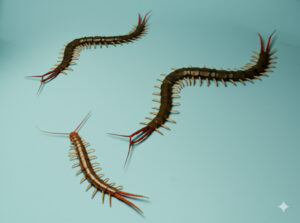Centipedes

When you encounter a swift, worm-like creature with numerous legs scurrying across your basement floor, it’s likely a centipede. These arthropods thrive in warm, humid environments and prey on small insects, making them a common sight in such areas. You might wonder: are they dangerous, or do they belong in our ecosystem?
Things to Know about Centipedes
When you find a house centipede in your home, it’s likely due to the presence of other pests and the centipede’s own preferences for warm, humid environments. Centipedes are drawn to the food sources they can find within your home, particularly small arthropods like cockroaches and insects. To manage these unwanted guests, it’s important to understand their behavior and habitat.
Here are three critical points to reflect on:
- Centipedes prefer warmth and moisture: Their ability to thrive in damp, humid spaces makes them common inhabitants of dark, hidden areas in your home, such as under rocks or logs.
- Centipedes primarily feed on small pests: Cockroaches, termites, silverfish, and other unwelcome insects are all part of their menu, which underscores the significance of addressing any underlying pest issues.
- Early detection is key: As they can spread easily within a home, recognizing the early signs of centipedes, such as the presence of their prey, is crucial to preventing a larger infestation.
Centipedes Dangerous or not
Despite their alarming appearance, house centipedes aren’t dangerous to humans. They primarily prey on small arthropods, and any bites are usually not severe unless you’re allergic to insect bites. Their venom is mainly designed to immobilize and kill their prey, such as insects and spiders.
However, when threatened or provoked, house centipedes can bite. These bites are generally mild and occasionally even break the skin, but they rarely cause significant irritation. If you do get bitten, you might experience slight pain, swelling, and redness. These symptoms typically subside within a few hours.
Unlike some other pests, house centipedes aren’t known to carry diseases, making them relatively harmless to humans. They’re more of a nuisance due to their fast movements and unsettling appearance.
The most effective way to deal with centipedes is to address the underlying issues, such as high humidity and the presence of their food sources, like insects and spiders. By tackling these issues, you can effectively manage centipede populations without having to resort to pesticides.

